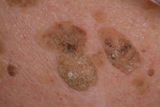Seborrheic keratoses are dark skin growths that appear in adulthood. Although they may be large and grow quickly, they are benign.


They are not caused by sun damage so they may be typically found on areas both covered and uncovered by clothing.
Even though they are benign, many patients are concerned that they are cancerous (malignant). These lesions often itch and even become irritated, making it necessary to remove them.
Seborrheic keratoses tend to run in families. Initially, they appear as slightly raised, light brown spots and evolve into darker, thicker lesions with rough, warty surfaces.
Seborrheic keratoses are generally harmless, and there aren’t many treatments beyond removing them. Some people choose to have them removed if the growths become unsightly, itch, or become irritated from rubbing against clothing. Removal methods include cryotherapy, shave biopsy, laser surgery, and curettage and cautery.
Because of their appearance, seborrheic keratoses can be confused with other skin growths, such as warts, moles, and the more worrisome actinic keratoses (AKs) and melanoma. See your doctor if you have concerns about such growths on your skin.
Images courtesy of Gerald Goldberg, M.D.
